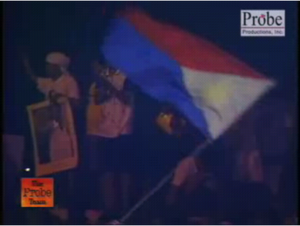This article needs additional citations for verification. (May 2022) |
| May 1 riots EDSA Tres | |||
|---|---|---|---|
 A still from an episode of The Probe Team that features Estrada loyalists marching toward Malacañang Palace, calling for the resignation of President Gloria Macapagal Arroyo. Note that the Philippine flag is flown with the red field upwards, a Philippine flag usage during a state of war. | |||
| Date | April 25–May 1, 2001 | ||
| Location | |||
| Caused by | Arrest of newly deposed President Joseph Estrada | ||
| Methods | Protest | ||
| Resulted in | Violent dispersal of protesters; declaration of a state of rebellion and arrest leaders of the opposition.[1] | ||
| Parties | |||
| |||
| Lead figures | |||
| Number | |||
| |||
| Casualties and losses | |||
The May 1 riots,[2] or EDSA III (pronounced as EDSA Three or EDSA Tres, the Spanish word for "three"), were protests sparked by the arrest of newly deposed president Joseph Estrada of the Philippines from April 25 to May 1, 2001. The protest was held for 7 days on a major highway in Metro Manila, Epifanio de los Santos Avenue (EDSA), which eventually culminated in an attempt to storm the Malacañang Palace.
Taking place four months after the Second EDSA Revolution, the protests were considered as a more populist uprising in comparison to the previous demonstrations in the same location in January 2001. The protests and the attack on the presidential palace, however, failed in their objectives. Participants continue to claim that it was a genuine People Power event, a claim disputed by the participants and supporters of EDSA II. President Gloria Macapagal Arroyo has acknowledged the divisive nature of the two terminologies by saying in one statement that she hoped to be the president of "EDSA II and EDSA III".[8]
- ^ Presidential Proclamation No. 38 Archived December 12, 2007, at the Wayback Machine
- ^ a b "PNP: No repeat of May 1 riots". The Philippine Star. April 29, 2002. Retrieved January 14, 2021.
- ^ a b "Pro-Estrada protests converge on presidential palace in Manila". Associated Press. April 30, 2001. Retrieved February 26, 2023.
- ^ "The government has now declared a state of rebellion". Associated Press. May 1, 2001. Retrieved February 26, 2023.
- ^ Nocum, Armand N.; Veridiano, Dave (May 3, 2001). "'Dead' cop hailed as living hero". Philippine Daily Inquirer. The Philippine Daily Inquirer, Inc. p. A1. Retrieved April 3, 2024.
- ^ Aning, Jerome (May 3, 2001). "Erap loyalists' rampage cost ₱100M". Philippine Daily Inquirer. The Philippine Daily Inquirer, Inc. p. A16. Retrieved April 3, 2024.
[Senior Supt. Nicolas] Pacinos clarified that the lone police fatality, PO3 Rolando Abello, was not killed during the dispersal.
- ^ "'TV Patrol' recounts EDSA 2 and 3 coverage". TV Patrol. January 9, 2020. Retrieved February 26, 2023.
- ^ Macapagal-Arroyo, Gloria (September 21, 2001). Sama-samang Pagkilos Kontra sa Kahirapan [Action Together Against Poverty] (Speech). National Basic Sector Anti-Poverty Conference. Golden Bay Hotel, Manila, Philippines.
...dahil ako ay presidente hindi lamang ng mga taga-EDSA 2. Ako ay presidente ng buong Pilipinas. Kaya naman ako rin ay presidente ng mga taga-EDSA 3
[...since I am president, not only of those in EDSA 2. I am the president of the entire Philippines. Hence, I am also president of those in EDSA 3.]
